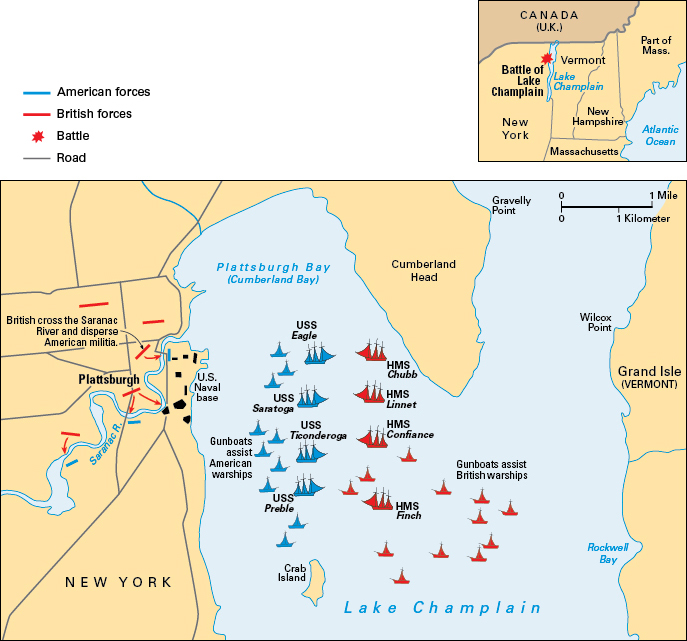Lake Champlain, Battle of, was one of the most important naval battles of the War of 1812 (1812-1815). It took place on Lake Champlain , in northeastern New York , in September 1814. An American naval squadron commanded by Lieutenant Thomas Macdonough forced the surrender of a British fleet.
Background.
In 1813, the Americans drove the British from Detroit and defeated a British fleet on Lake Erie . American forces briefly occupied York (now Toronto), the capital of British Upper Canada . In July 1814, in Canada , the Americans won the Battle of Chippewa . They also fought the British to a bloody standstill at the Battle of Lundy’s Lane . In August, British troops overwhelmed the defenders of Washington, D.C. , and set the American capital aflame.

On August 31, Sir George Prevost, the governor general of Canada, led about 10,000 British soldiers south from Canada. His objective was the American naval base at Plattsburgh, New York. The British marched along the western shore of Lake Champlain toward Plattsburgh. They reached the Saranac River, just north of the American defenses, on September 6.
The British were supported by 4 warships and 12 smaller gunboats under Captain George Downie. Defending Plattsburgh were about 4,500 American troops under Brigadier General Alexander Macomb. On Lake Champlain, a small American squadron commanded by Thomas Macdonough prepared for the British attack. Macdonough’s fleet consisted of 4 warships—including his flagship, the _Saratoga—_and 10 gunboats. The ships were anchored in line inside Plattsburgh Bay, part of Lake Champlain.
The naval battle.
Downie’s British squadron approached the American squadron at about 8 a.m. on September 11. Downie’s flagship, the Confiance, struck the Saratoga with a powerful broadside attack (fire from all the guns on one side of a ship). Shortly afterward, however, a shot from the Saratoga struck one of the Confiance’s cannons . The shot knocked the cannon against Downie, killing him.
Macdonough maneuvered the Saratoga to direct the guns on its other side toward the enemy. The Saratoga pounded the Confiance so heavily that the British sailors refused to continue the fight. British Lieutenant James Robertson, who had taken over the ship after Downie’s death, surrendered at about 10:30 a.m.
The land battle.
The British also planned a land attack at Plattsburgh on September 11. British troops under Major General Frederick Robinson crossed the Saranac River and dispersed New York militia (citizen army) soldiers on the river’s south bank. However, when Prevost learned that the British fleet had been defeated, he called off the attack on Plattsburgh. Prevost feared that the Americans could disrupt the British supply lines, and he ordered a retreat to Canada. The Americans, who were outnumbered, were surprised by the British withdrawal.
Aftermath.
In the land battle at Plattsburgh, about 100 American soldiers and 82 British soldiers were killed or wounded. On Plattsburgh Bay, the losses were about 110 for the Americans and about 170 for the British. In addition, dozens of soldiers and hundreds of sailors on the British side were captured.
Many British officers criticized Prevost’s decision to abandon the land attack. In 1815, British authorities summoned Prevost to London to defend his actions. He requested a court martial (military court) to clear his name. However, he died in January 1816, shortly before the proceedings could begin.
